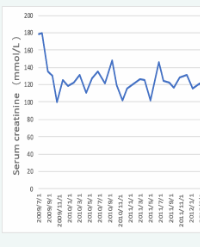
Clinical Observation of Traditional Chinese Medicine in the Treatment of Diabetic Kidney Disease: A Clinical Case Series
Aim : Diabetic kidney disease (DKD) is a critical microvascular complication of diabetes and the main cause of in end-stage renal disease (ESRD). Conventional clinical treatments for blood glucose, blood pressure, and blood lipid control include ACEI/ARB drugs and other symptomatic treatments, which do not control disease progression. Therefore, in the present study, we assessed the effectiveness of a Chinese medicinal therapy for the treatment of DKD, ameliorating patients’ clinical symptoms, controlling proteinuria, delaying the progression of DKD, and protecting renal function.
Methods : From July 2007 to January 2018, we assessed five DKD patients. We collected data on these patients’ symptoms, physical examination findings, and physicochemical examination findings at multiple visits. Patient medical records were reviewed retrospectively. also improved.
Results : In the five cases reported, clinical symptoms such as edema and urine foam were obviously relieved or even resolved completely. Serum creatinine (Scr) decreased or was maintained, and the 24-hour urinary protein tended to decrease. In the course of treatment, not only were no adverse reactions observed, but patient renal functioning improved or remained stable. Patient quality of life also improved.
Conclusion : Shenzhuo formula is a promising and safe method for the treatment of DKD and is thus worthy of further controlled clinical and mechanistic studies.
Lili Zhang1#, Jiang Ma2#, Yu Wei3#, Rumeng Tang3, Linhua Zhao1*, and Xiaolin Tong1*


